HRM Case Study: Stakeholders, Ethics, and Motivation Theories
VerifiedAdded on 2023/06/04
|10
|2683
|493
Case Study
AI Summary
This case study delves into a scenario involving Star Construction Company, where bribery and ethical dilemmas significantly impact human resource management. It identifies key stakeholders such as the Construction Workers Union, Star Construction Company, its employees, and labor union officials, highlighting the conflicts arising from poor working conditions and alleged bribery attempts. The analysis explores the ethical implications of Mike Murphy's actions, the owner of Star Construction, in trying to influence labor union negotiations. Furthermore, it applies Maslow's Hierarchy of Needs to address employee motivation and the Expectancy Theory to understand Mike Murphy's behavior. The study concludes by examining the ethical issues of bribery, integrity, and transparency within the company, emphasizing the importance of ethical conduct and stakeholder management in HRM. Desklib offers a platform to explore similar case studies and solved assignments for students.
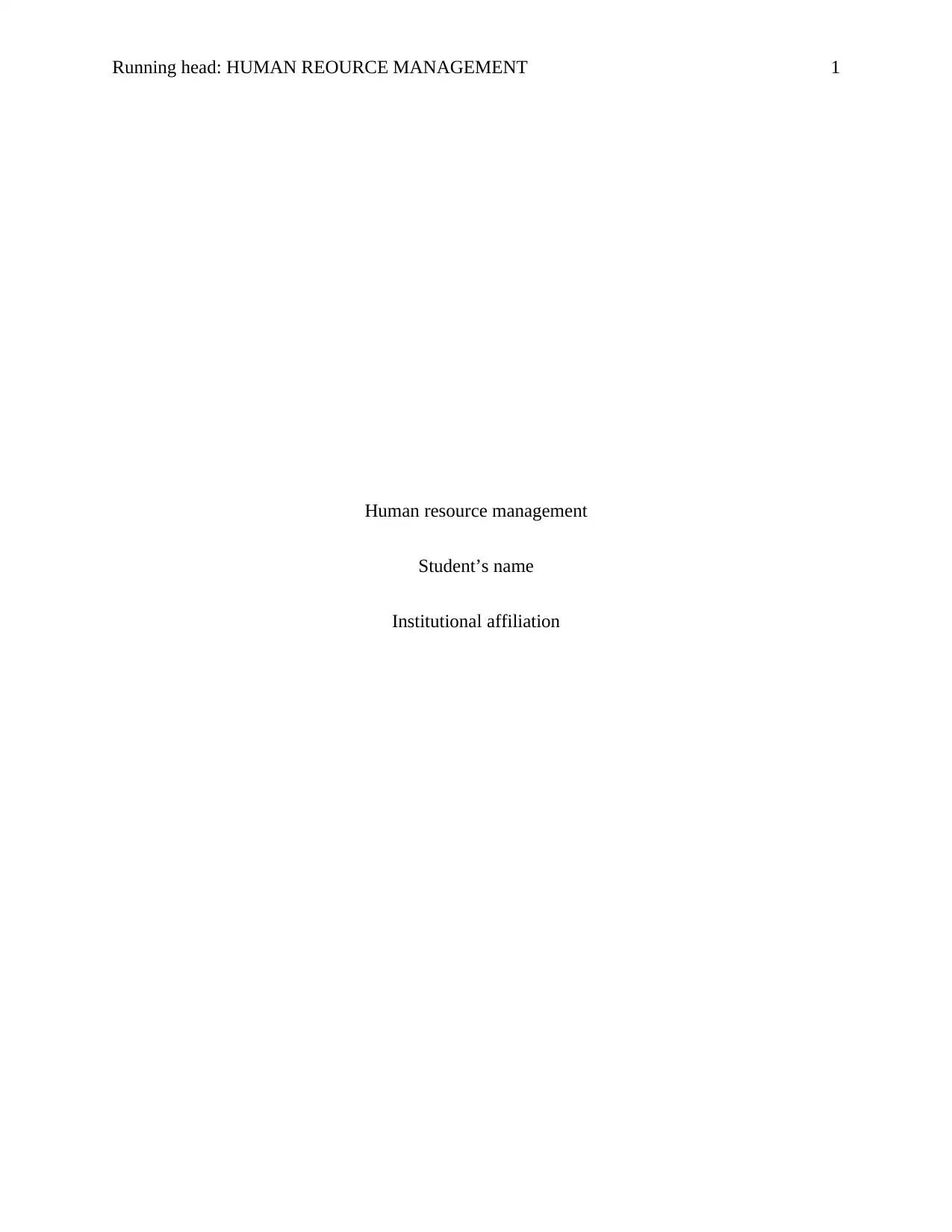
Running head: HUMAN REOURCE MANAGEMENT 1
Human resource management
Student’s name
Institutional affiliation
Human resource management
Student’s name
Institutional affiliation
Paraphrase This Document
Need a fresh take? Get an instant paraphrase of this document with our AI Paraphraser
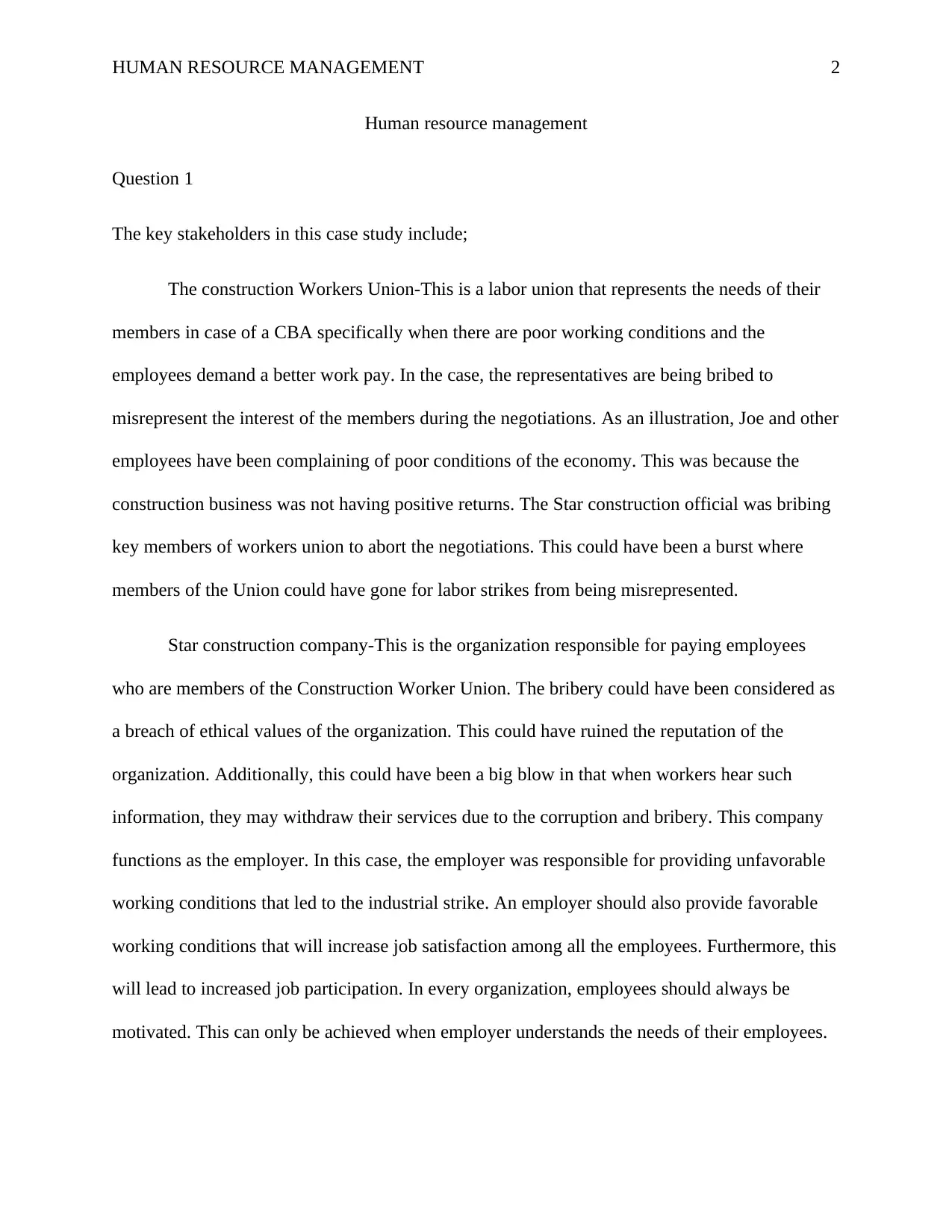
HUMAN RESOURCE MANAGEMENT 2
Human resource management
Question 1
The key stakeholders in this case study include;
The construction Workers Union-This is a labor union that represents the needs of their
members in case of a CBA specifically when there are poor working conditions and the
employees demand a better work pay. In the case, the representatives are being bribed to
misrepresent the interest of the members during the negotiations. As an illustration, Joe and other
employees have been complaining of poor conditions of the economy. This was because the
construction business was not having positive returns. The Star construction official was bribing
key members of workers union to abort the negotiations. This could have been a burst where
members of the Union could have gone for labor strikes from being misrepresented.
Star construction company-This is the organization responsible for paying employees
who are members of the Construction Worker Union. The bribery could have been considered as
a breach of ethical values of the organization. This could have ruined the reputation of the
organization. Additionally, this could have been a big blow in that when workers hear such
information, they may withdraw their services due to the corruption and bribery. This company
functions as the employer. In this case, the employer was responsible for providing unfavorable
working conditions that led to the industrial strike. An employer should also provide favorable
working conditions that will increase job satisfaction among all the employees. Furthermore, this
will lead to increased job participation. In every organization, employees should always be
motivated. This can only be achieved when employer understands the needs of their employees.
Human resource management
Question 1
The key stakeholders in this case study include;
The construction Workers Union-This is a labor union that represents the needs of their
members in case of a CBA specifically when there are poor working conditions and the
employees demand a better work pay. In the case, the representatives are being bribed to
misrepresent the interest of the members during the negotiations. As an illustration, Joe and other
employees have been complaining of poor conditions of the economy. This was because the
construction business was not having positive returns. The Star construction official was bribing
key members of workers union to abort the negotiations. This could have been a burst where
members of the Union could have gone for labor strikes from being misrepresented.
Star construction company-This is the organization responsible for paying employees
who are members of the Construction Worker Union. The bribery could have been considered as
a breach of ethical values of the organization. This could have ruined the reputation of the
organization. Additionally, this could have been a big blow in that when workers hear such
information, they may withdraw their services due to the corruption and bribery. This company
functions as the employer. In this case, the employer was responsible for providing unfavorable
working conditions that led to the industrial strike. An employer should also provide favorable
working conditions that will increase job satisfaction among all the employees. Furthermore, this
will lead to increased job participation. In every organization, employees should always be
motivated. This can only be achieved when employer understands the needs of their employees.
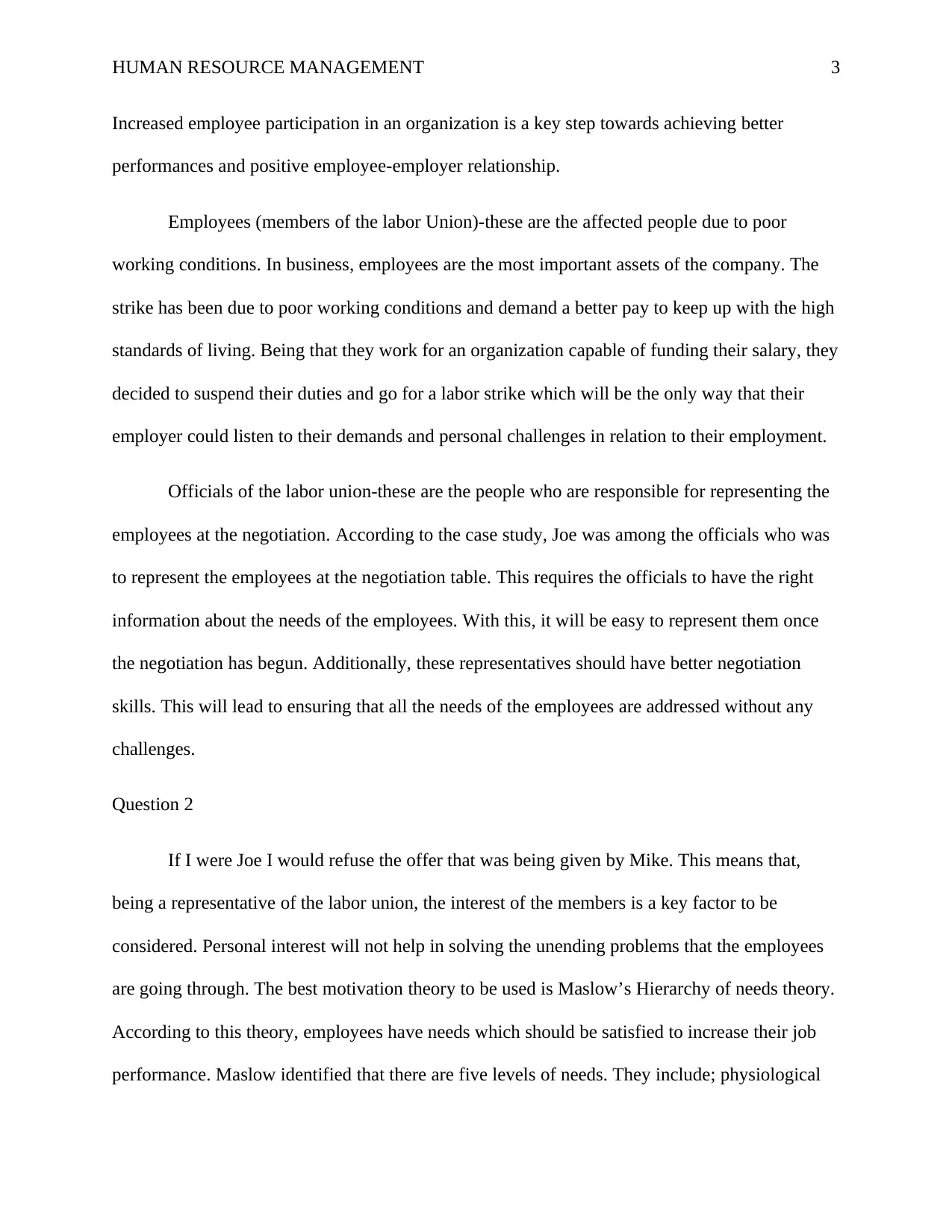
HUMAN RESOURCE MANAGEMENT 3
Increased employee participation in an organization is a key step towards achieving better
performances and positive employee-employer relationship.
Employees (members of the labor Union)-these are the affected people due to poor
working conditions. In business, employees are the most important assets of the company. The
strike has been due to poor working conditions and demand a better pay to keep up with the high
standards of living. Being that they work for an organization capable of funding their salary, they
decided to suspend their duties and go for a labor strike which will be the only way that their
employer could listen to their demands and personal challenges in relation to their employment.
Officials of the labor union-these are the people who are responsible for representing the
employees at the negotiation. According to the case study, Joe was among the officials who was
to represent the employees at the negotiation table. This requires the officials to have the right
information about the needs of the employees. With this, it will be easy to represent them once
the negotiation has begun. Additionally, these representatives should have better negotiation
skills. This will lead to ensuring that all the needs of the employees are addressed without any
challenges.
Question 2
If I were Joe I would refuse the offer that was being given by Mike. This means that,
being a representative of the labor union, the interest of the members is a key factor to be
considered. Personal interest will not help in solving the unending problems that the employees
are going through. The best motivation theory to be used is Maslow’s Hierarchy of needs theory.
According to this theory, employees have needs which should be satisfied to increase their job
performance. Maslow identified that there are five levels of needs. They include; physiological
Increased employee participation in an organization is a key step towards achieving better
performances and positive employee-employer relationship.
Employees (members of the labor Union)-these are the affected people due to poor
working conditions. In business, employees are the most important assets of the company. The
strike has been due to poor working conditions and demand a better pay to keep up with the high
standards of living. Being that they work for an organization capable of funding their salary, they
decided to suspend their duties and go for a labor strike which will be the only way that their
employer could listen to their demands and personal challenges in relation to their employment.
Officials of the labor union-these are the people who are responsible for representing the
employees at the negotiation. According to the case study, Joe was among the officials who was
to represent the employees at the negotiation table. This requires the officials to have the right
information about the needs of the employees. With this, it will be easy to represent them once
the negotiation has begun. Additionally, these representatives should have better negotiation
skills. This will lead to ensuring that all the needs of the employees are addressed without any
challenges.
Question 2
If I were Joe I would refuse the offer that was being given by Mike. This means that,
being a representative of the labor union, the interest of the members is a key factor to be
considered. Personal interest will not help in solving the unending problems that the employees
are going through. The best motivation theory to be used is Maslow’s Hierarchy of needs theory.
According to this theory, employees have needs which should be satisfied to increase their job
performance. Maslow identified that there are five levels of needs. They include; physiological
⊘ This is a preview!⊘
Do you want full access?
Subscribe today to unlock all pages.

Trusted by 1+ million students worldwide
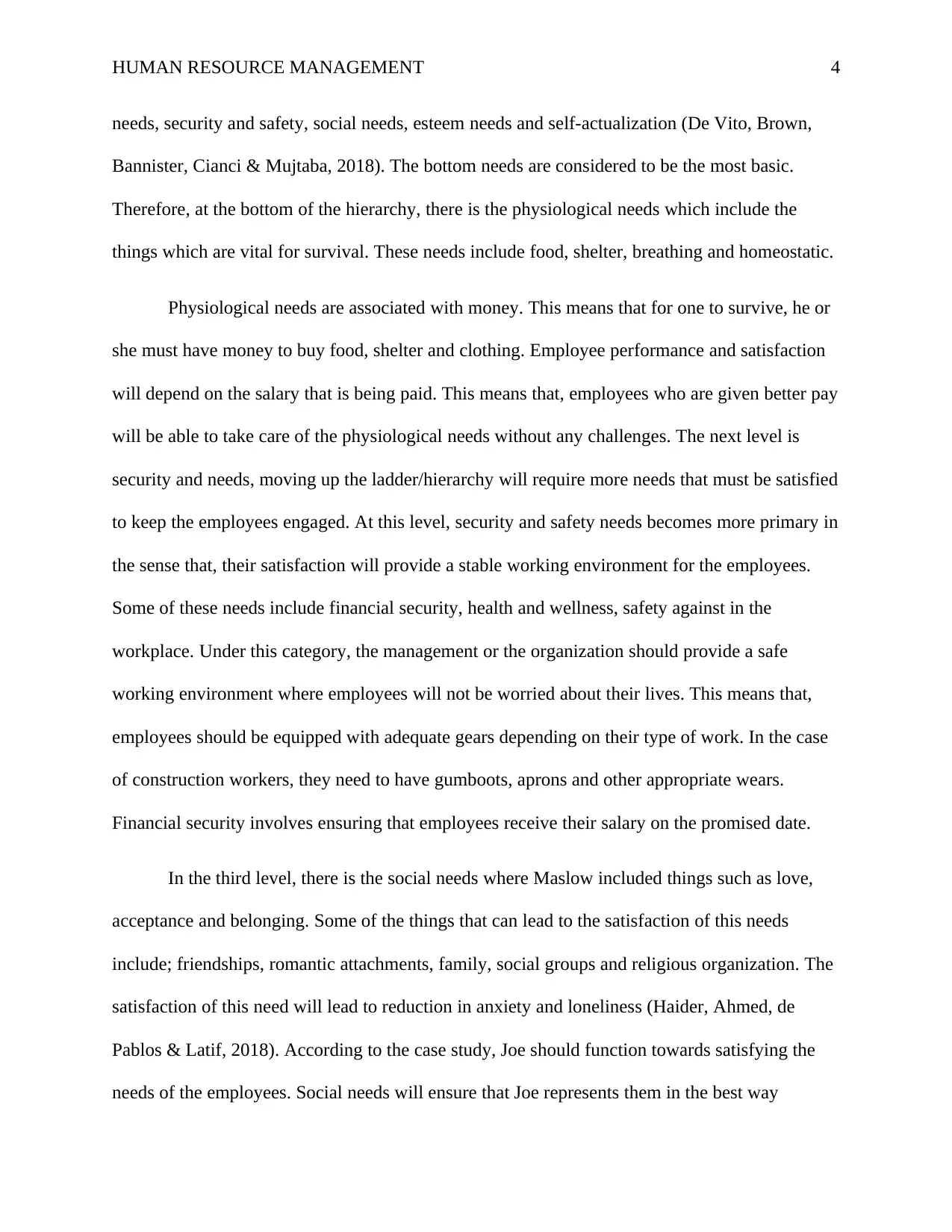
HUMAN RESOURCE MANAGEMENT 4
needs, security and safety, social needs, esteem needs and self-actualization (De Vito, Brown,
Bannister, Cianci & Mujtaba, 2018). The bottom needs are considered to be the most basic.
Therefore, at the bottom of the hierarchy, there is the physiological needs which include the
things which are vital for survival. These needs include food, shelter, breathing and homeostatic.
Physiological needs are associated with money. This means that for one to survive, he or
she must have money to buy food, shelter and clothing. Employee performance and satisfaction
will depend on the salary that is being paid. This means that, employees who are given better pay
will be able to take care of the physiological needs without any challenges. The next level is
security and needs, moving up the ladder/hierarchy will require more needs that must be satisfied
to keep the employees engaged. At this level, security and safety needs becomes more primary in
the sense that, their satisfaction will provide a stable working environment for the employees.
Some of these needs include financial security, health and wellness, safety against in the
workplace. Under this category, the management or the organization should provide a safe
working environment where employees will not be worried about their lives. This means that,
employees should be equipped with adequate gears depending on their type of work. In the case
of construction workers, they need to have gumboots, aprons and other appropriate wears.
Financial security involves ensuring that employees receive their salary on the promised date.
In the third level, there is the social needs where Maslow included things such as love,
acceptance and belonging. Some of the things that can lead to the satisfaction of this needs
include; friendships, romantic attachments, family, social groups and religious organization. The
satisfaction of this need will lead to reduction in anxiety and loneliness (Haider, Ahmed, de
Pablos & Latif, 2018). According to the case study, Joe should function towards satisfying the
needs of the employees. Social needs will ensure that Joe represents them in the best way
needs, security and safety, social needs, esteem needs and self-actualization (De Vito, Brown,
Bannister, Cianci & Mujtaba, 2018). The bottom needs are considered to be the most basic.
Therefore, at the bottom of the hierarchy, there is the physiological needs which include the
things which are vital for survival. These needs include food, shelter, breathing and homeostatic.
Physiological needs are associated with money. This means that for one to survive, he or
she must have money to buy food, shelter and clothing. Employee performance and satisfaction
will depend on the salary that is being paid. This means that, employees who are given better pay
will be able to take care of the physiological needs without any challenges. The next level is
security and needs, moving up the ladder/hierarchy will require more needs that must be satisfied
to keep the employees engaged. At this level, security and safety needs becomes more primary in
the sense that, their satisfaction will provide a stable working environment for the employees.
Some of these needs include financial security, health and wellness, safety against in the
workplace. Under this category, the management or the organization should provide a safe
working environment where employees will not be worried about their lives. This means that,
employees should be equipped with adequate gears depending on their type of work. In the case
of construction workers, they need to have gumboots, aprons and other appropriate wears.
Financial security involves ensuring that employees receive their salary on the promised date.
In the third level, there is the social needs where Maslow included things such as love,
acceptance and belonging. Some of the things that can lead to the satisfaction of this needs
include; friendships, romantic attachments, family, social groups and religious organization. The
satisfaction of this need will lead to reduction in anxiety and loneliness (Haider, Ahmed, de
Pablos & Latif, 2018). According to the case study, Joe should function towards satisfying the
needs of the employees. Social needs will ensure that Joe represents them in the best way
Paraphrase This Document
Need a fresh take? Get an instant paraphrase of this document with our AI Paraphraser
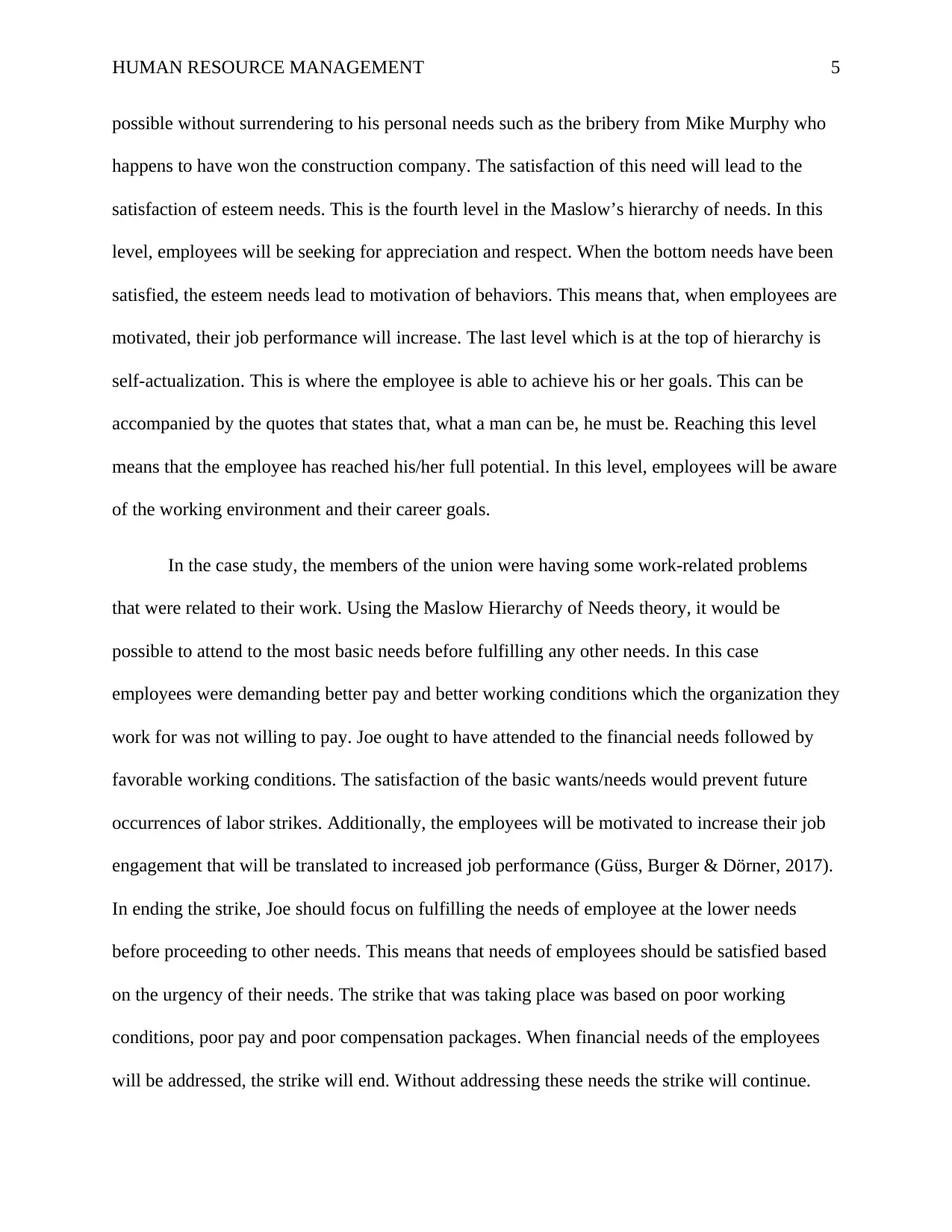
HUMAN RESOURCE MANAGEMENT 5
possible without surrendering to his personal needs such as the bribery from Mike Murphy who
happens to have won the construction company. The satisfaction of this need will lead to the
satisfaction of esteem needs. This is the fourth level in the Maslow’s hierarchy of needs. In this
level, employees will be seeking for appreciation and respect. When the bottom needs have been
satisfied, the esteem needs lead to motivation of behaviors. This means that, when employees are
motivated, their job performance will increase. The last level which is at the top of hierarchy is
self-actualization. This is where the employee is able to achieve his or her goals. This can be
accompanied by the quotes that states that, what a man can be, he must be. Reaching this level
means that the employee has reached his/her full potential. In this level, employees will be aware
of the working environment and their career goals.
In the case study, the members of the union were having some work-related problems
that were related to their work. Using the Maslow Hierarchy of Needs theory, it would be
possible to attend to the most basic needs before fulfilling any other needs. In this case
employees were demanding better pay and better working conditions which the organization they
work for was not willing to pay. Joe ought to have attended to the financial needs followed by
favorable working conditions. The satisfaction of the basic wants/needs would prevent future
occurrences of labor strikes. Additionally, the employees will be motivated to increase their job
engagement that will be translated to increased job performance (Güss, Burger & Dörner, 2017).
In ending the strike, Joe should focus on fulfilling the needs of employee at the lower needs
before proceeding to other needs. This means that needs of employees should be satisfied based
on the urgency of their needs. The strike that was taking place was based on poor working
conditions, poor pay and poor compensation packages. When financial needs of the employees
will be addressed, the strike will end. Without addressing these needs the strike will continue.
possible without surrendering to his personal needs such as the bribery from Mike Murphy who
happens to have won the construction company. The satisfaction of this need will lead to the
satisfaction of esteem needs. This is the fourth level in the Maslow’s hierarchy of needs. In this
level, employees will be seeking for appreciation and respect. When the bottom needs have been
satisfied, the esteem needs lead to motivation of behaviors. This means that, when employees are
motivated, their job performance will increase. The last level which is at the top of hierarchy is
self-actualization. This is where the employee is able to achieve his or her goals. This can be
accompanied by the quotes that states that, what a man can be, he must be. Reaching this level
means that the employee has reached his/her full potential. In this level, employees will be aware
of the working environment and their career goals.
In the case study, the members of the union were having some work-related problems
that were related to their work. Using the Maslow Hierarchy of Needs theory, it would be
possible to attend to the most basic needs before fulfilling any other needs. In this case
employees were demanding better pay and better working conditions which the organization they
work for was not willing to pay. Joe ought to have attended to the financial needs followed by
favorable working conditions. The satisfaction of the basic wants/needs would prevent future
occurrences of labor strikes. Additionally, the employees will be motivated to increase their job
engagement that will be translated to increased job performance (Güss, Burger & Dörner, 2017).
In ending the strike, Joe should focus on fulfilling the needs of employee at the lower needs
before proceeding to other needs. This means that needs of employees should be satisfied based
on the urgency of their needs. The strike that was taking place was based on poor working
conditions, poor pay and poor compensation packages. When financial needs of the employees
will be addressed, the strike will end. Without addressing these needs the strike will continue.
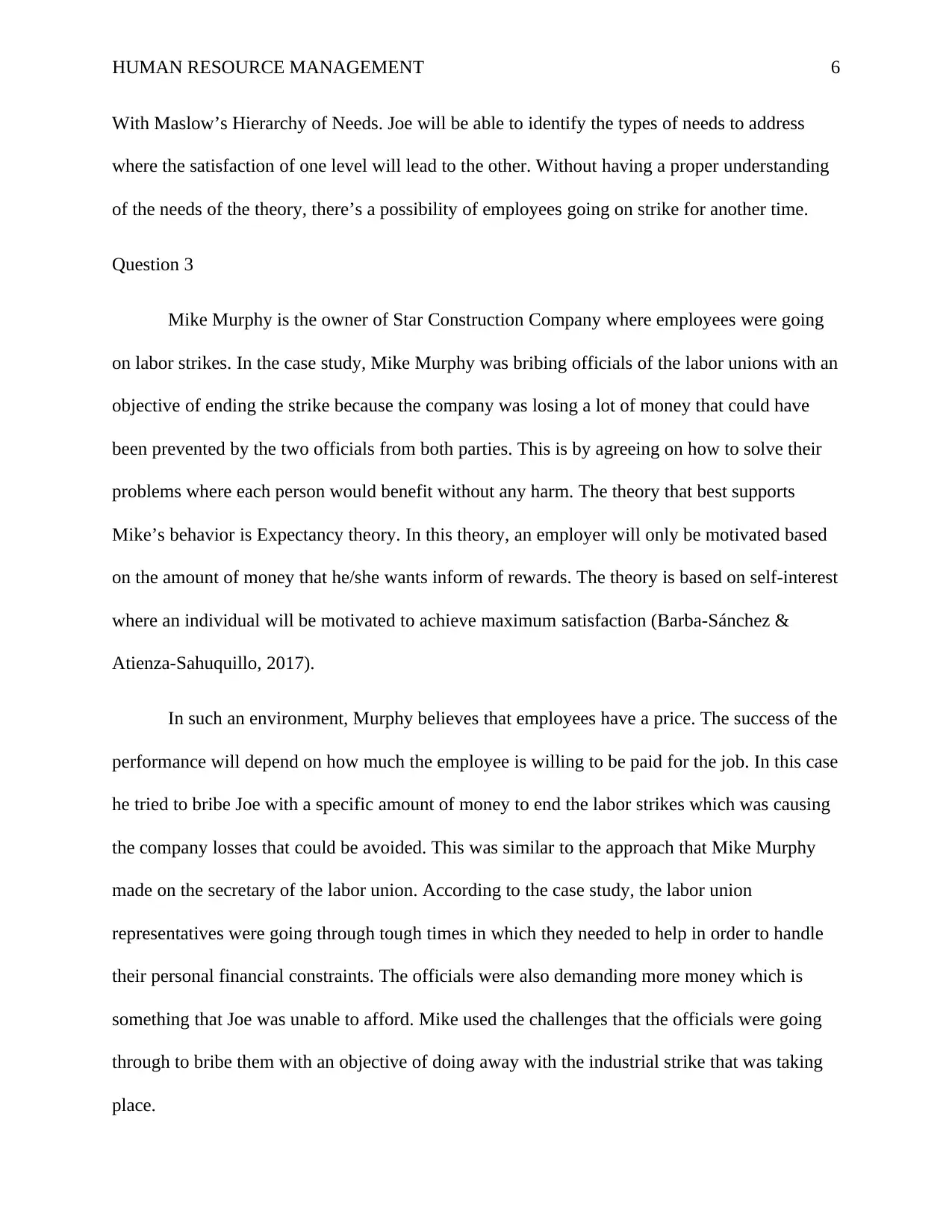
HUMAN RESOURCE MANAGEMENT 6
With Maslow’s Hierarchy of Needs. Joe will be able to identify the types of needs to address
where the satisfaction of one level will lead to the other. Without having a proper understanding
of the needs of the theory, there’s a possibility of employees going on strike for another time.
Question 3
Mike Murphy is the owner of Star Construction Company where employees were going
on labor strikes. In the case study, Mike Murphy was bribing officials of the labor unions with an
objective of ending the strike because the company was losing a lot of money that could have
been prevented by the two officials from both parties. This is by agreeing on how to solve their
problems where each person would benefit without any harm. The theory that best supports
Mike’s behavior is Expectancy theory. In this theory, an employer will only be motivated based
on the amount of money that he/she wants inform of rewards. The theory is based on self-interest
where an individual will be motivated to achieve maximum satisfaction (Barba-Sánchez &
Atienza-Sahuquillo, 2017).
In such an environment, Murphy believes that employees have a price. The success of the
performance will depend on how much the employee is willing to be paid for the job. In this case
he tried to bribe Joe with a specific amount of money to end the labor strikes which was causing
the company losses that could be avoided. This was similar to the approach that Mike Murphy
made on the secretary of the labor union. According to the case study, the labor union
representatives were going through tough times in which they needed to help in order to handle
their personal financial constraints. The officials were also demanding more money which is
something that Joe was unable to afford. Mike used the challenges that the officials were going
through to bribe them with an objective of doing away with the industrial strike that was taking
place.
With Maslow’s Hierarchy of Needs. Joe will be able to identify the types of needs to address
where the satisfaction of one level will lead to the other. Without having a proper understanding
of the needs of the theory, there’s a possibility of employees going on strike for another time.
Question 3
Mike Murphy is the owner of Star Construction Company where employees were going
on labor strikes. In the case study, Mike Murphy was bribing officials of the labor unions with an
objective of ending the strike because the company was losing a lot of money that could have
been prevented by the two officials from both parties. This is by agreeing on how to solve their
problems where each person would benefit without any harm. The theory that best supports
Mike’s behavior is Expectancy theory. In this theory, an employer will only be motivated based
on the amount of money that he/she wants inform of rewards. The theory is based on self-interest
where an individual will be motivated to achieve maximum satisfaction (Barba-Sánchez &
Atienza-Sahuquillo, 2017).
In such an environment, Murphy believes that employees have a price. The success of the
performance will depend on how much the employee is willing to be paid for the job. In this case
he tried to bribe Joe with a specific amount of money to end the labor strikes which was causing
the company losses that could be avoided. This was similar to the approach that Mike Murphy
made on the secretary of the labor union. According to the case study, the labor union
representatives were going through tough times in which they needed to help in order to handle
their personal financial constraints. The officials were also demanding more money which is
something that Joe was unable to afford. Mike used the challenges that the officials were going
through to bribe them with an objective of doing away with the industrial strike that was taking
place.
⊘ This is a preview!⊘
Do you want full access?
Subscribe today to unlock all pages.

Trusted by 1+ million students worldwide
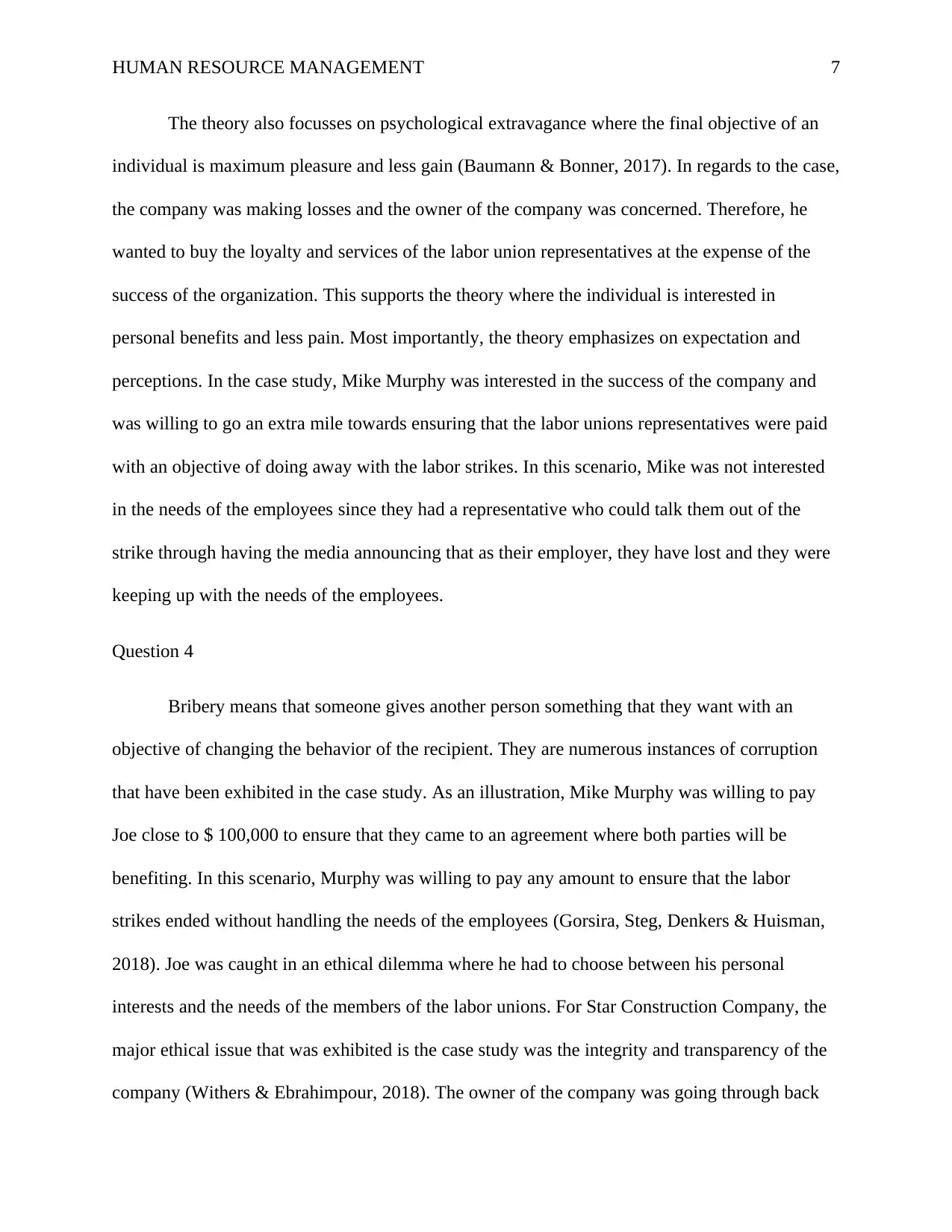
HUMAN RESOURCE MANAGEMENT 7
The theory also focusses on psychological extravagance where the final objective of an
individual is maximum pleasure and less gain (Baumann & Bonner, 2017). In regards to the case,
the company was making losses and the owner of the company was concerned. Therefore, he
wanted to buy the loyalty and services of the labor union representatives at the expense of the
success of the organization. This supports the theory where the individual is interested in
personal benefits and less pain. Most importantly, the theory emphasizes on expectation and
perceptions. In the case study, Mike Murphy was interested in the success of the company and
was willing to go an extra mile towards ensuring that the labor unions representatives were paid
with an objective of doing away with the labor strikes. In this scenario, Mike was not interested
in the needs of the employees since they had a representative who could talk them out of the
strike through having the media announcing that as their employer, they have lost and they were
keeping up with the needs of the employees.
Question 4
Bribery means that someone gives another person something that they want with an
objective of changing the behavior of the recipient. They are numerous instances of corruption
that have been exhibited in the case study. As an illustration, Mike Murphy was willing to pay
Joe close to $ 100,000 to ensure that they came to an agreement where both parties will be
benefiting. In this scenario, Murphy was willing to pay any amount to ensure that the labor
strikes ended without handling the needs of the employees (Gorsira, Steg, Denkers & Huisman,
2018). Joe was caught in an ethical dilemma where he had to choose between his personal
interests and the needs of the members of the labor unions. For Star Construction Company, the
major ethical issue that was exhibited is the case study was the integrity and transparency of the
company (Withers & Ebrahimpour, 2018). The owner of the company was going through back
The theory also focusses on psychological extravagance where the final objective of an
individual is maximum pleasure and less gain (Baumann & Bonner, 2017). In regards to the case,
the company was making losses and the owner of the company was concerned. Therefore, he
wanted to buy the loyalty and services of the labor union representatives at the expense of the
success of the organization. This supports the theory where the individual is interested in
personal benefits and less pain. Most importantly, the theory emphasizes on expectation and
perceptions. In the case study, Mike Murphy was interested in the success of the company and
was willing to go an extra mile towards ensuring that the labor unions representatives were paid
with an objective of doing away with the labor strikes. In this scenario, Mike was not interested
in the needs of the employees since they had a representative who could talk them out of the
strike through having the media announcing that as their employer, they have lost and they were
keeping up with the needs of the employees.
Question 4
Bribery means that someone gives another person something that they want with an
objective of changing the behavior of the recipient. They are numerous instances of corruption
that have been exhibited in the case study. As an illustration, Mike Murphy was willing to pay
Joe close to $ 100,000 to ensure that they came to an agreement where both parties will be
benefiting. In this scenario, Murphy was willing to pay any amount to ensure that the labor
strikes ended without handling the needs of the employees (Gorsira, Steg, Denkers & Huisman,
2018). Joe was caught in an ethical dilemma where he had to choose between his personal
interests and the needs of the members of the labor unions. For Star Construction Company, the
major ethical issue that was exhibited is the case study was the integrity and transparency of the
company (Withers & Ebrahimpour, 2018). The owner of the company was going through back
Paraphrase This Document
Need a fresh take? Get an instant paraphrase of this document with our AI Paraphraser
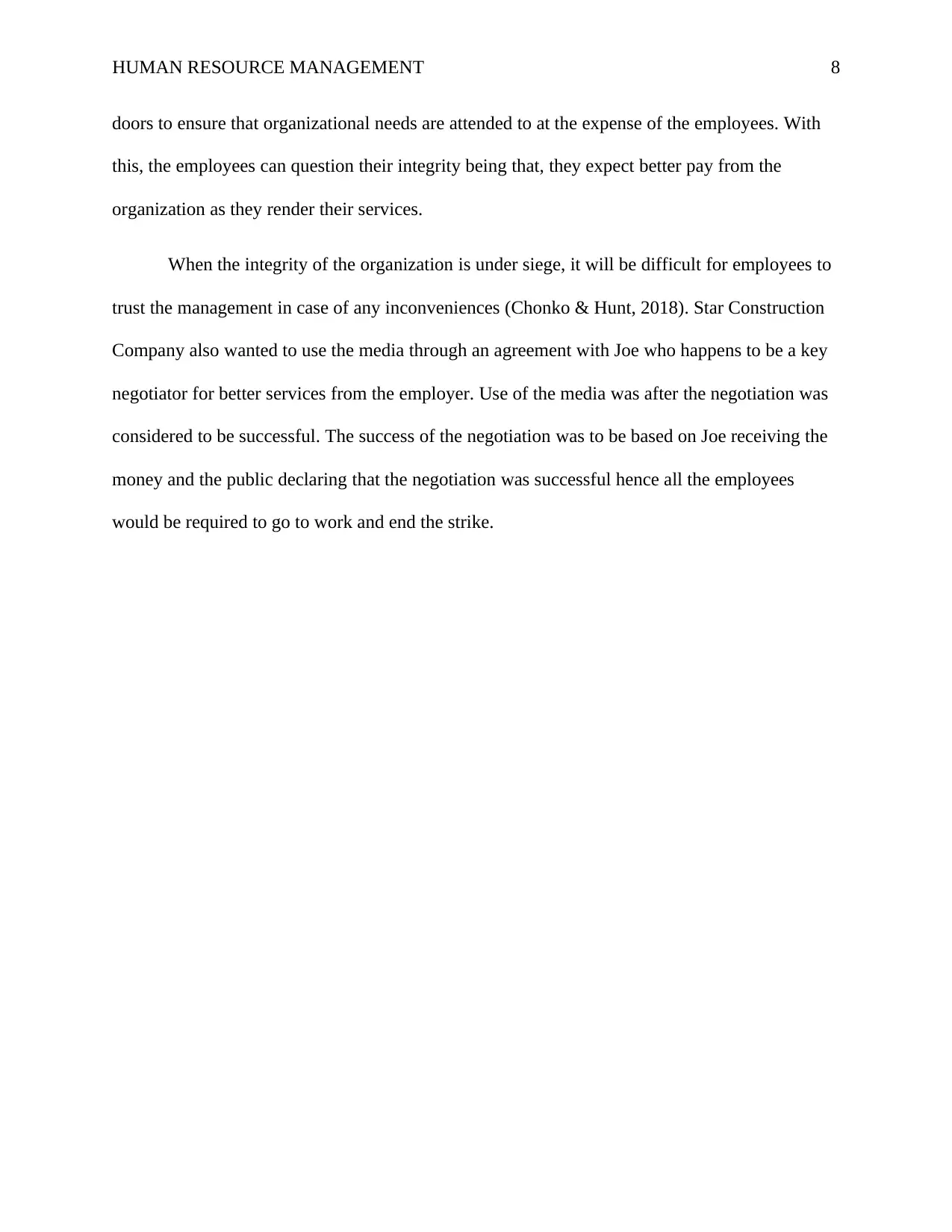
HUMAN RESOURCE MANAGEMENT 8
doors to ensure that organizational needs are attended to at the expense of the employees. With
this, the employees can question their integrity being that, they expect better pay from the
organization as they render their services.
When the integrity of the organization is under siege, it will be difficult for employees to
trust the management in case of any inconveniences (Chonko & Hunt, 2018). Star Construction
Company also wanted to use the media through an agreement with Joe who happens to be a key
negotiator for better services from the employer. Use of the media was after the negotiation was
considered to be successful. The success of the negotiation was to be based on Joe receiving the
money and the public declaring that the negotiation was successful hence all the employees
would be required to go to work and end the strike.
doors to ensure that organizational needs are attended to at the expense of the employees. With
this, the employees can question their integrity being that, they expect better pay from the
organization as they render their services.
When the integrity of the organization is under siege, it will be difficult for employees to
trust the management in case of any inconveniences (Chonko & Hunt, 2018). Star Construction
Company also wanted to use the media through an agreement with Joe who happens to be a key
negotiator for better services from the employer. Use of the media was after the negotiation was
considered to be successful. The success of the negotiation was to be based on Joe receiving the
money and the public declaring that the negotiation was successful hence all the employees
would be required to go to work and end the strike.
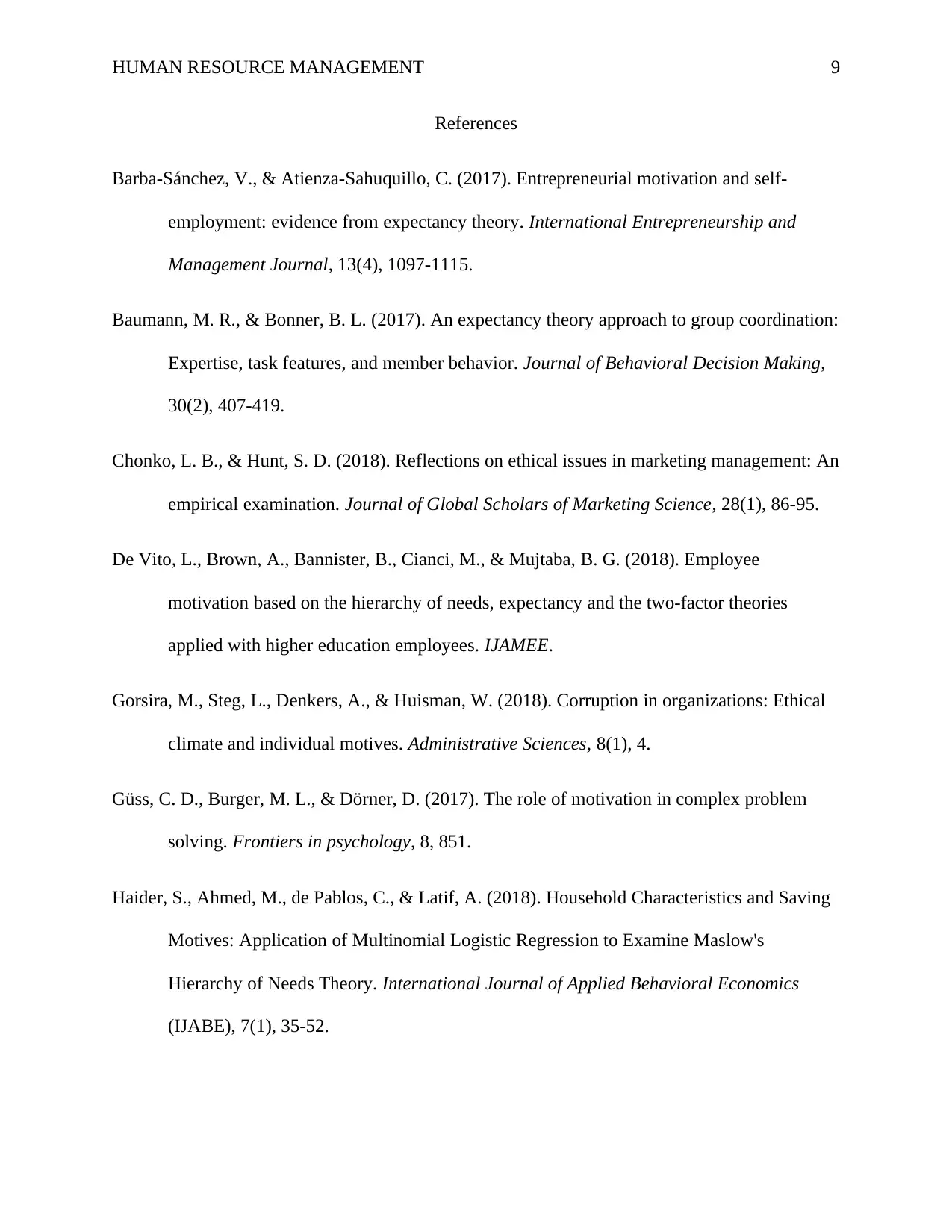
HUMAN RESOURCE MANAGEMENT 9
References
Barba-Sánchez, V., & Atienza-Sahuquillo, C. (2017). Entrepreneurial motivation and self-
employment: evidence from expectancy theory. International Entrepreneurship and
Management Journal, 13(4), 1097-1115.
Baumann, M. R., & Bonner, B. L. (2017). An expectancy theory approach to group coordination:
Expertise, task features, and member behavior. Journal of Behavioral Decision Making,
30(2), 407-419.
Chonko, L. B., & Hunt, S. D. (2018). Reflections on ethical issues in marketing management: An
empirical examination. Journal of Global Scholars of Marketing Science, 28(1), 86-95.
De Vito, L., Brown, A., Bannister, B., Cianci, M., & Mujtaba, B. G. (2018). Employee
motivation based on the hierarchy of needs, expectancy and the two-factor theories
applied with higher education employees. IJAMEE.
Gorsira, M., Steg, L., Denkers, A., & Huisman, W. (2018). Corruption in organizations: Ethical
climate and individual motives. Administrative Sciences, 8(1), 4.
Güss, C. D., Burger, M. L., & Dörner, D. (2017). The role of motivation in complex problem
solving. Frontiers in psychology, 8, 851.
Haider, S., Ahmed, M., de Pablos, C., & Latif, A. (2018). Household Characteristics and Saving
Motives: Application of Multinomial Logistic Regression to Examine Maslow's
Hierarchy of Needs Theory. International Journal of Applied Behavioral Economics
(IJABE), 7(1), 35-52.
References
Barba-Sánchez, V., & Atienza-Sahuquillo, C. (2017). Entrepreneurial motivation and self-
employment: evidence from expectancy theory. International Entrepreneurship and
Management Journal, 13(4), 1097-1115.
Baumann, M. R., & Bonner, B. L. (2017). An expectancy theory approach to group coordination:
Expertise, task features, and member behavior. Journal of Behavioral Decision Making,
30(2), 407-419.
Chonko, L. B., & Hunt, S. D. (2018). Reflections on ethical issues in marketing management: An
empirical examination. Journal of Global Scholars of Marketing Science, 28(1), 86-95.
De Vito, L., Brown, A., Bannister, B., Cianci, M., & Mujtaba, B. G. (2018). Employee
motivation based on the hierarchy of needs, expectancy and the two-factor theories
applied with higher education employees. IJAMEE.
Gorsira, M., Steg, L., Denkers, A., & Huisman, W. (2018). Corruption in organizations: Ethical
climate and individual motives. Administrative Sciences, 8(1), 4.
Güss, C. D., Burger, M. L., & Dörner, D. (2017). The role of motivation in complex problem
solving. Frontiers in psychology, 8, 851.
Haider, S., Ahmed, M., de Pablos, C., & Latif, A. (2018). Household Characteristics and Saving
Motives: Application of Multinomial Logistic Regression to Examine Maslow's
Hierarchy of Needs Theory. International Journal of Applied Behavioral Economics
(IJABE), 7(1), 35-52.
⊘ This is a preview!⊘
Do you want full access?
Subscribe today to unlock all pages.

Trusted by 1+ million students worldwide
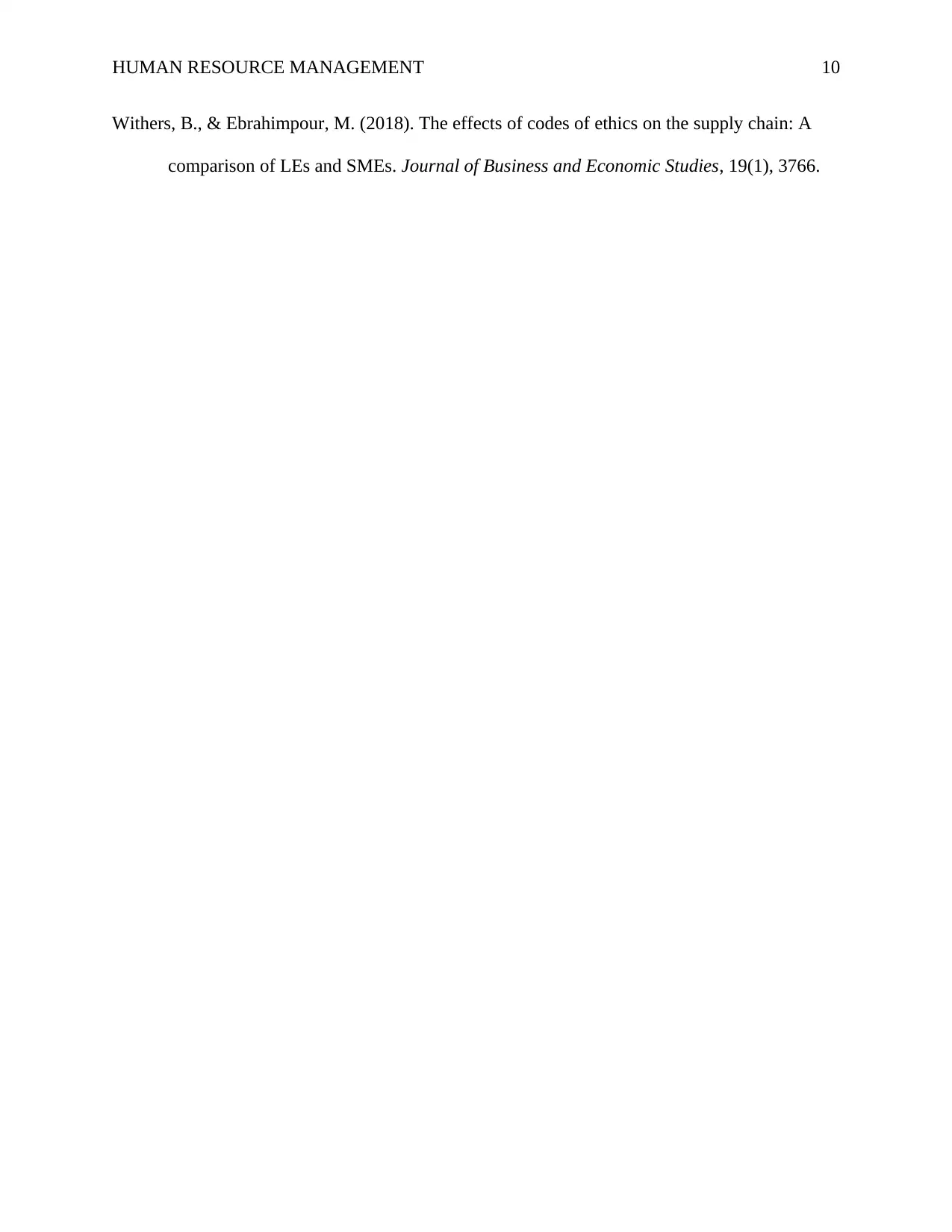
HUMAN RESOURCE MANAGEMENT 10
Withers, B., & Ebrahimpour, M. (2018). The effects of codes of ethics on the supply chain: A
comparison of LEs and SMEs. Journal of Business and Economic Studies, 19(1), 3766.
Withers, B., & Ebrahimpour, M. (2018). The effects of codes of ethics on the supply chain: A
comparison of LEs and SMEs. Journal of Business and Economic Studies, 19(1), 3766.
1 out of 10
Related Documents
Your All-in-One AI-Powered Toolkit for Academic Success.
+13062052269
info@desklib.com
Available 24*7 on WhatsApp / Email
![[object Object]](/_next/static/media/star-bottom.7253800d.svg)
Unlock your academic potential
Copyright © 2020–2025 A2Z Services. All Rights Reserved. Developed and managed by ZUCOL.





